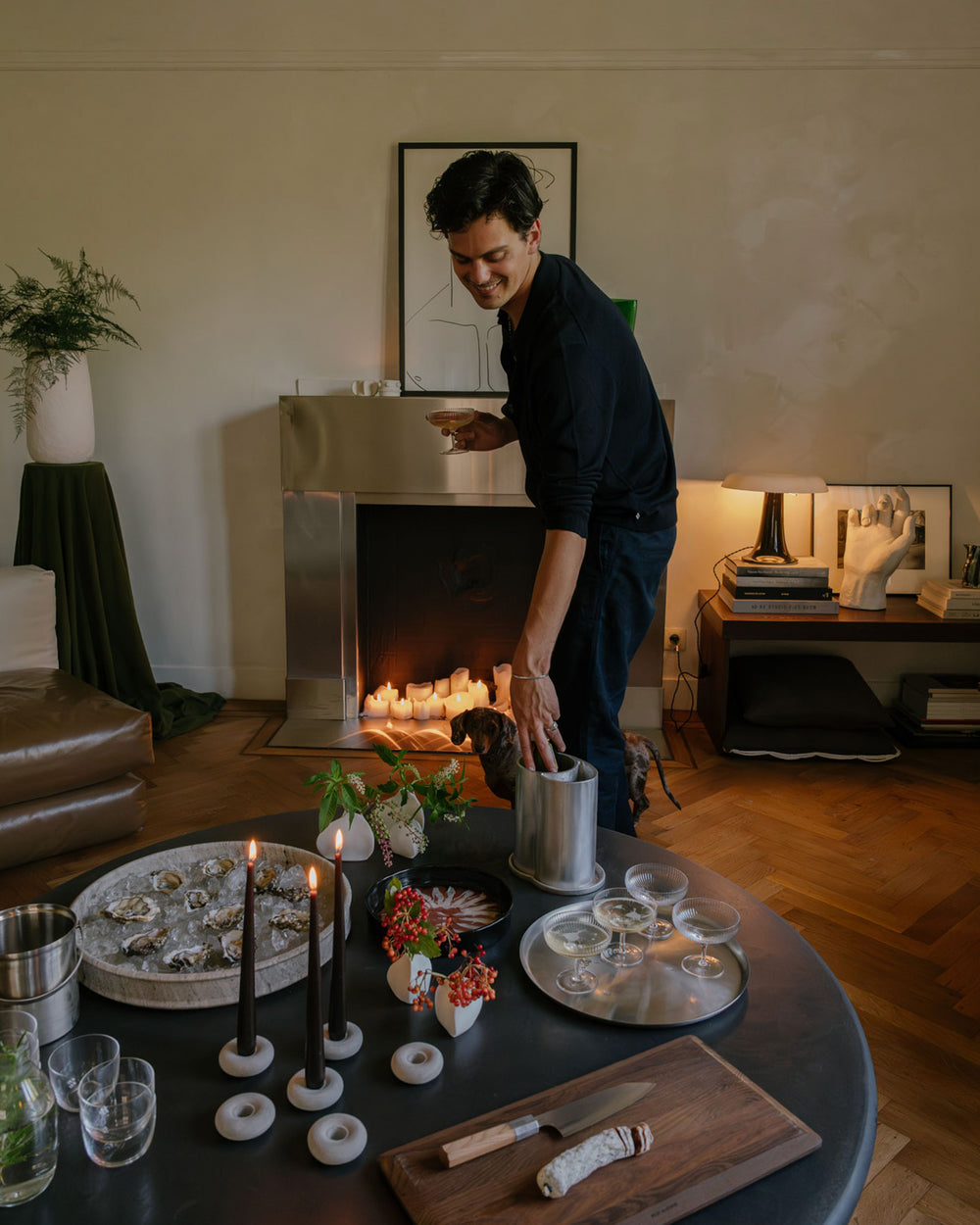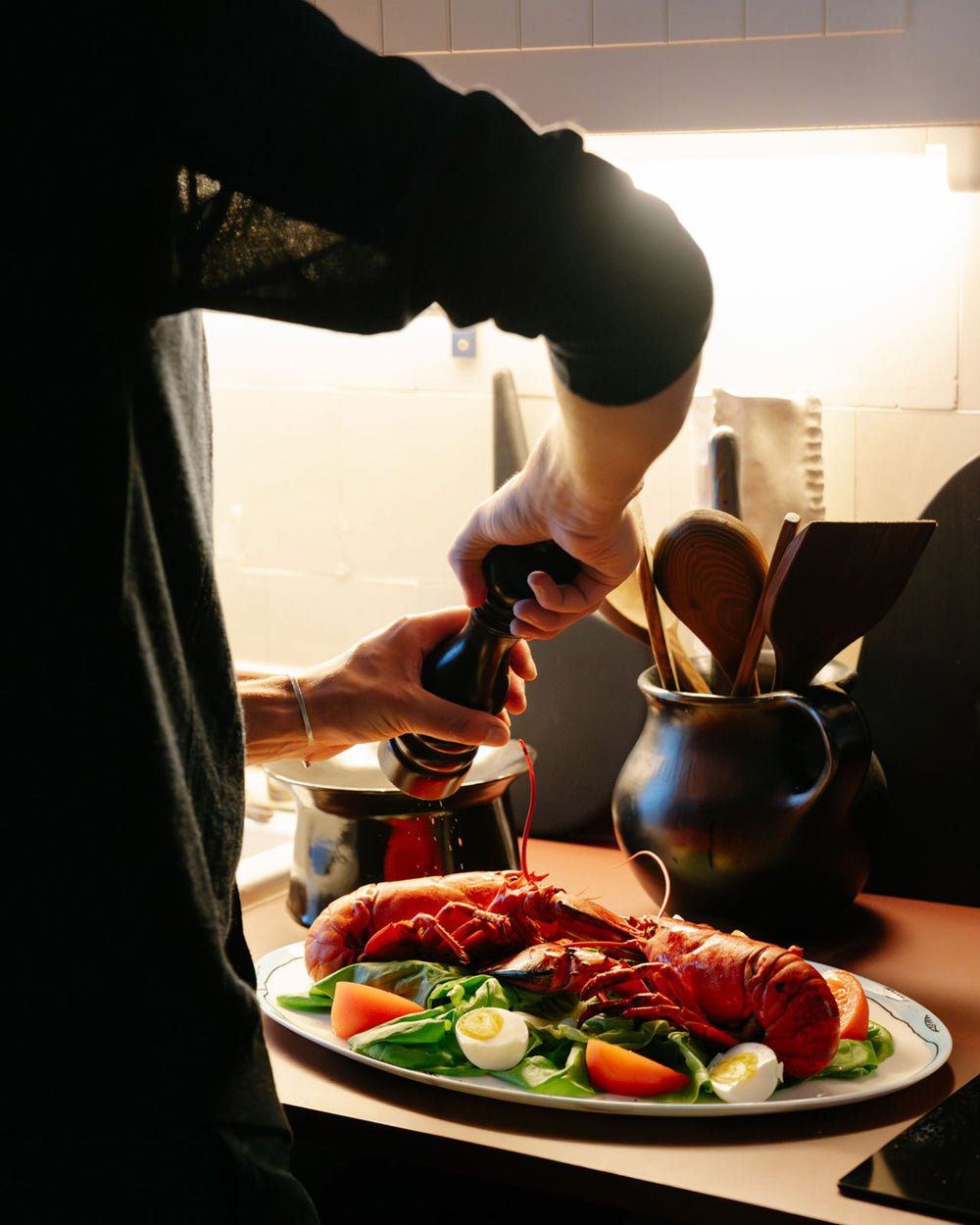A style edit
The secrets behind the festive table unravelled
The holidays are approaching. Although that is good news, it can also lead to some tension. After all, how do you arrange the party table so that it conveys the love you feel for your guests? For inspiration, Serax visited the home of Olivier De Croock and Hannes Lefevere, a couple who combine gastronomy with a keen eye for design. What follows is a simple but oh-so-essential guide.
So, dropping in on Hannes and Olivier is pretty obvious. The couple has long earned their stripes in gastronomy and everything that gravitates around it. Hannes, for example, studied at the renowned hotel school Spermalie and earned his stripes for eight years as the manager of Graanmarkt 13, the restaurant where top chef Seppe Nobels stirred the pots at that time. Ever since Hannes met Olivier, he’s been back behind the fire. “Olivier likes to invite friends at home and gently force them to stand in the kitchen”, he laughs. “That made me want to get back to cooking”. “I like to host”, Oliver adds. That is no coincidence, either. After four years of working for a top-tier florist, Olivier is a master in table arrangement and design interiors. Recently, the five-star Hotel Botanic Sanctuary Antwerp asked Olivier to give the new shop an exciting design. “I have been a perfectionist since childhood, and I am very orderly.”

Keep it sober
Hannes and Olivier’s festive dinner fits perfectly between the orderly and the sumptuous. “We like an aesthetic that radiates warmth, but nevertheless opt for tableware in neutral colours,” says Olivier. “It’s the flowers and the dishes that stand out”. “Sometimes coloured plates influence the palatability of a dish,” says Hannes. “On a nice white plate, a dish always looks good. That’s why I’ve sworn by Piet Boon’s plates for years. They are extremely sober and very sturdy — that’s something you are sensitive to as a hospitality person.” Olivier: “You can also style neutral-coloured tableware completely differently with every meal. Good tableware is a safe investment. So it would be a shame to confine yourself to one style or worse: going out of fashion.”
“On a nice white plate, a dish always looks good. That’s why I’ve sworn by Piet Boon’s plates for years. They are extremely sober and very sturdy — that’s something you are sensitive to as a hospitality person.”
A busy table
Despite the neutrally-coloured plates, the couple’s festive dinner is very rich. How do they make that happen? Simple: by filling the table properly. “If the colours are neutral, you can fill the table without it looking like a cacophony,” says Olivier. “It doesn’t have to look too neat. We fill the table until there’s really no room left.” The couple does this by combining different sober collections. “For example, we combined Piet Boon’s plates with a bottom plate by Kelly Wearstler,” says Olivier. “Don’t play with colours, but with different materials and sizes.” Hannes: “A golden tip: work with heights too. For example, we chose some bowls on a high foot from Marie Michielssen’s La Mère collection to create elevation differences.”

Still life
Olivier and Hannes fill the spaces between the plates and scales with candles and flowers. “I really use a lot of candles,” says Olivier. “Do not use lamps. Candlelight is so much more cosy.” “Actually, we always aim to create a still life,” says Hannes. “The table can really be a composition, a picture.” Olivier: “Start with one piece and build the rest around it. So we put Kelly Wearstler’s high-footed bowl in the middle first, and then we decided the rest.”
A little quirky
In the multitude of coherent plates and bowls, we notice one subtle disturbance: the Fish&Fish fish bowl by Paola Navone. Although a perfectionist, Olivier had to leave the iconic bowl for this party table, Hannes insisted. “I know that it doesn’t fit in perfectly with the rest,” he says, “Just one item that doesn’t seem to be right adds a certain character to the table, I think.” The fish by Navone is a little splash of humour. It’s a subtle conversation piece. “Like myself, this bowl is a little "quirky" at the gathering.” (laughs)
Vases everywhere
According to Olivier, colour is applied by using flowers. “You start best by choosing a basic flower, and from there, you build on it,” he says. Arranging flowers is no easy job, but Olivier offers a solution: use many small vases that you spread over the table. “Three to four flowers per vase is enough. Once again, play with higher and lower heights. If you choose flowers that are not too compact but also show enough stem, you create a lush but sober and airy atmosphere. One more tip: first, place the vases on the table and then fill them one by one. Don’t try to manipulate the flowers too much. Let their natural forms speak.”
One product per dish
The most important part of the festive dinner is the dishes. “I am a person with the principle that you should be able to see what is in the dish at a glance,” says Hannes. “This is how I serve almost every product separately. For example, I rearranged the lettuce as a crop. I’ll serve the dressing next to it.” In short, deconstruct the dishes to create multiplicity. “Because of the many dishes, the guests can keep busy with the food all the time: they talk about it, they move the dishes around and so on. That means there’s never a silent moment at the table.”
Keep it simple
Hannes also encourages you to choose dishes that you can prepare in advance or require little attention during dinner. “If the host disappears into the kitchen half the time, it isn’t pleasant for the guests,” he says. “As a cook, I also want to sit at the table. That’s why I choose efficient dishes that shouldn’t need taming. In fact, I am of the principle of putting the cooking pots on the table. Considering it’s a festive table, I’m replacing those pots with nicer dishes. In short, it’s a more aesthetic version of a family meal.”
Goodbye plastic bottle
Olivier gives a few more finishing tips. One of them: put fruit on the table. “It’s really no work at all, and it makes the table instantly beautiful,” he says. “Red grapes or even red cabbage or radicchio immediately create the atmosphere of a still life,” adds Hannes. “Please do not put a plastic bottle on the table! “Oliver says. “Put the water in a nice jug.” Another potential atmosphere creator is a cute four-legged friend who sticks its nose in everywhere. But these experts don’t dare to recommend that right away.














































































